Epoxy vs Polyurea vs Polyaspartic
What’s the big hype around these new coatings known as “polyurea” or “polyaspartic”? Are they really that much better than epoxy? And if so, how?
Brady Green - CEO
4/2/20256 min read
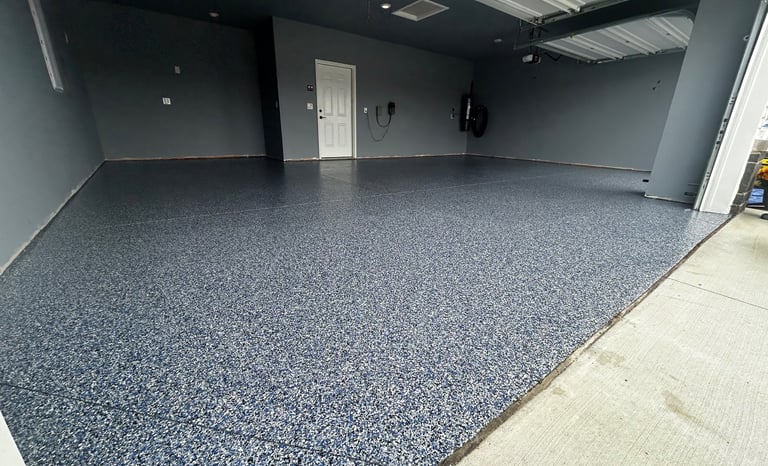

What's Really the Best Option for my Garage?
So what even is Polyaspartic or Polyurea?
Polyurea and polyaspartic have a similar chemical makeup, as they come from the same poly family, but have slight differences in performance, usability, and formulation. Polyurea is defined as an elastomeric substance created by combining an isocyanate compound with a synthetic resinous compound. It’s primarily formulated for direct-to-concrete use. This is for a couple of reasons: more open time to work with and broadcast into, better concrete adhesion, and the fact that it’s typically non-aliphatic (aromatic), meaning it’s not formulated for UV stability.
Polyaspartic, on the other hand, is primarily formulated for topcoat purposes. It’s made up of the same isocyanates and synthetic compounds as polyurea, but is engineered to be aliphatic (UV-stable).
In other words: all polyaspartic is polyurea, but not all polyurea is polyaspartic.
Polyaspartics have quicker cure times, cure faster in thin mils (so they have less open time), are UV-stable, and have improved scratch and chemical resistance.
Both polyurea and polyaspartic provide elastomeric benefits, quick cure times which lead to fast return to service, and have an exothermic curing reaction — meaning they create their own heat to properly cure in low temperatures, even as low as -15°F. Both are good products, but just like all coatings, they each have their time and place.
4X Stronger Than Epoxy??
You’ve seen it everywhere — on ads, signs, social media, even blasting through your radio.
“Ditch epoxy and upgrade to a coating that’s 4X stronger!”
It’s a bold claim. But what does it actually mean?
Stronger how? Tensile strength? Bond strength? Flexural strength? Or is it just marketing buzz?
When it comes to measuring a product's performance, manufacturers put coatings through a series of standardized physical performance tests — evaluating everything from durability to flexibility. The results of those tests are compiled into a Technical Data Sheet (TDS).The TDS is essentially the product’s resume — listing out critical specs like application directions, recommended coverage, working time, solids content, and most importantly, physical performance metrics. It’s the science behind the promises. Without it, you're trusting a product to perform as you were told without any relying or backing data. So, if we really want to understand what “4X stronger” means, the TDS sheet holds all of our answers.
Shall we take a look?
Before we dive right into the comparative TDS sheets, lets first get some of the big terminology out of the way.
Compressive Strength: Measures resistance to crushing.
Tensile Strength: Measures resistance to pulling apart.
Flexural Strength: Measures resistance to bending.
Adhesion Strength: Measures the bond between the coating and the substrate.
Hardness: Measures resistance to scratching or indentation.
Unfortunately, many manufacturers don't publish all of the data for their polyureas or polyaspartics. This makes it difficult to make a direct comparison across all the parameters of "strength" testing. Because of this, I’ll be referencing some of the biggest manufacturers’ TDS sheets and putting them side by side. That way, we can look at a broad range of data points for comparison across different product lines to see if any stats truly come close to a 4X strength variance.

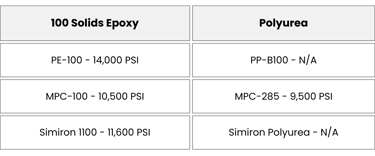
Compressive Strength
So, as we can see here, there are zero stats that show or prove any claim of 20X, 4X, or even 2X stronger than epoxy. In fact, if anything, epoxy takes the cake when it comes to compressive strength. due to the polyurea nature of flexibility however, this makes sense. So, let's keep moving.


Tensile Strength
Again, nothing to prove any severe strength difference, especially in favor of polyurea.
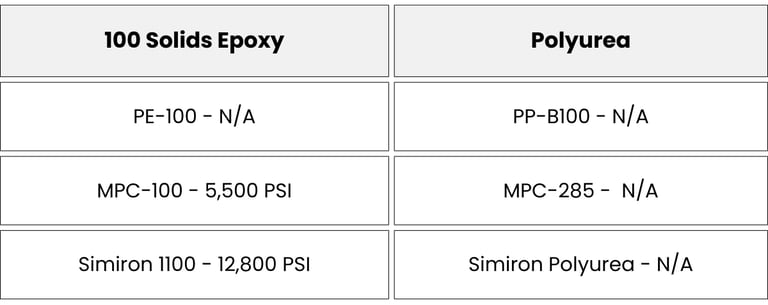

Flexural Strength
Interesting one to not have any data for, right? they claim how it's not only 4x stronger than epoxy, but 98% more flexible as well with zero data to back the flexural strength in relation to epoxy.
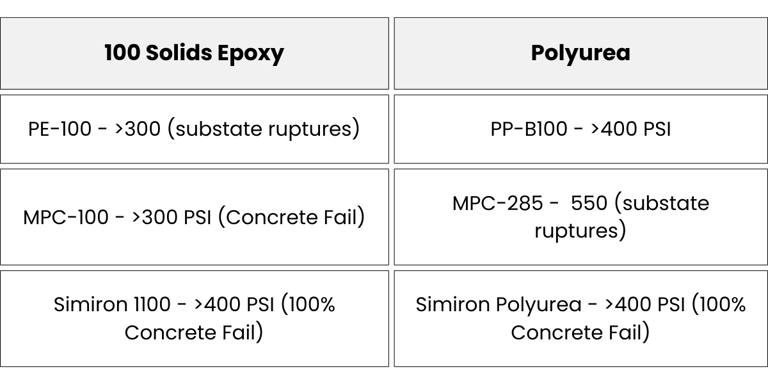

Adhesion Strength
Again, nothing that is 4x stronger than epoxy here. When looking at Adhesion data all we really care about is that the concrete will break before my product will. So even if polyurea did truly have a 1,600 psi or even a 12,000 psi strength it wouldn't matter. Concrete really only has a 300 psi pull tolerance before it pops, so as long as my product has a bond stronger than 300 psi it doesn't matter.
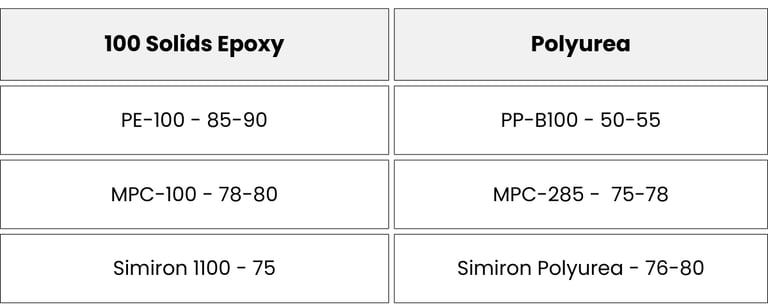

Hardness
And last but not least, hardness. Think of this as a grade scale. 0 being referenced as a tire Tred, and 80 being referenced as a hard hat.
As you’ve seen from the stats shared here, not a single result shows polyurea being 4 times stronger than epoxy. Every figure comes directly from the manufacturer’s Technical Data Sheets (TDS), based on third-party required ASTM testing standards. These are the same manufacturers who invest millions into rigorous testing and product development, taking full responsibility for their performance and data shown on the TDS.
Where We Stand
With all the comparative test data we've shared, you might be wondering: Is epoxy really better than polyurea? Where does polyaspartic fit in? The truth is, every product has its time and place. Each one performs differently under specific conditions and excels in certain environments.
Here's how we approach it: 9 times out of 10, when a coating fails, it’s due to improper preparation. There’s a saying in this business: "Your coating is only as good as what it's sticking to." Neither polyurea nor epoxy will perform well on a garage floor if proper prep work isn’t done before installation. And no, acid etching and power washing don’t count as prep. These methods don’t remove weak laitance or the top layer of concrete needed to expose deeper aggregate or create the necessary mechanical profile for a strong bond.
Both epoxy and polyurea can ideally last 15-20 years (assuming no moisture or slab issues), as long as professional, thorough preparation is done. The second most significant factor affecting floor failures is moisture. Polyurea, by nature, is more sensitive to moisture than epoxy. While both are waterproof, they each react differently to moisture vapor transmission and hydrostatic pressure from within the slab. Epoxies can simply tolerate more moisture, which is why no moisture vapor barrier (MVB) has been developed within the polyurea resin matrix.
Another Concept to point out is product millage rates or thickness. Polyurea's are not only thinner products, but called out in TDS sheets for thinner applications. Although they bond very well, flooring should be the furthest thing away from painting or rolling a thin mill coating over a slab. And when I'm installing a floor that is going to last, I want a high build, thick system that not only will bond well and resist moisture, but also have its own body over the floor. Which is the exact benefit of the flake in the first place. So why stop short of a proper high build basecoat? In fact, epoxies usually go down 1.5X thicker than polyurea. I even see some professional and local companies add thinners to their polyurea's, stretching them even more.
Given this, along with the data above, we use a variety of both based on proper conditions of install. In the summer months when proper cure temps are available, we prefer to use an epoxy hybrid system. Our basecoat features a built-in moisture vapor barrier, combining the durability of epoxy with the flexibility and cure speed of polyurea. This gives you the best of both worlds. In the winter months, epoxy systems are non-applicable due to temps. We use a high solid polyurea basecoat to ensure proper curing in temps even below zero. However, we like to inform the customer of the differences and always offer the choice between the two systems as both have their pros and cons.
On every flake-installed floor, a polyaspartic topcoat will be installed. This is required for superior scratch resistance, faster return-to-service times, and, most importantly, UV resistance. There’s no debate when it comes to selecting a topcoat for a flake floor – polyaspartic is the clear choice over polyurea or epoxy.
We hope this clears the air on some of the marketing gimmicks out there. This article wasn’t meant to discredit polyurea systems, but rather to shed light on the truth behind these products and demonstrate that every coating has its time and place. Just like with many things in life, there is no one-size-fits-all solution, especially when it comes to floor coatings. Each product excels under different conditions, but none are 20x, 4x, or even 2x stronger or better than another.
At the end of the day, what truly matters is working with a reliable, professional company that understands the differences between these products. A company that can recommend and install the right system for your specific needs, ensuring your floor will hold up to the current conditions while being honest and transparent about what’s best for you.
CONTACTS
248-702-5226
Cuttingedgecoats@gmail.com
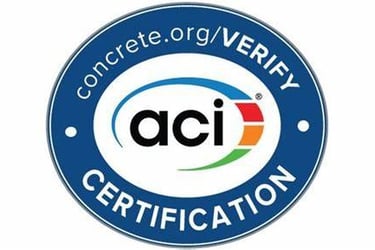




Direct Links
Clean Coat
Service Area
Oakland County
Livingston County
Washtenaw County
